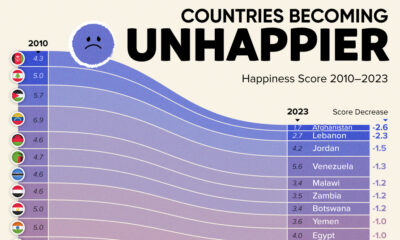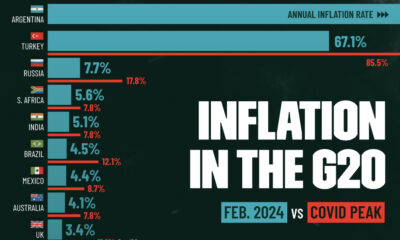Misc
The Impact of International Students on the U.S. Economy

The Economic Impact of America’s International Students
For decades, the U.S. has been the top destination for students looking to study abroad.
It’s easy to see why. Not only does the country provide access to world-class economic hubs like Silicon Valley, but the U.S. is also home to 14 of the top 20 universities in the world, many of which are famed for their research and alumni networks.
Yet, there is cause for concern.
International enrollments in the U.S. have slowed, while other countries are attracting a larger share of the global talent pool. To help us understand what’s at stake if enrollments continue to decline, today’s infographic shows the impact of international students on the U.S. economy.
Driving American Innovation and Growth
International students and scholars are a vital economic asset, and America’s ability to attract them puts the country in an enviable position.
First, there are the direct economic benefits which result from tuition fees and living expenses. Throughout the 2018/2019 school year, these benefits totaled $41 billion, a comparable value to many other American exports:
| Export | Value (2018) |
|---|---|
| Automobiles | $158B |
| Commercial Aircraft | $131B |
| Pharmaceuticals | $51B |
| Education Exports | $41B |
| Telecommunications Equipment | $36B |
| Soybeans | $17B |
Source: NAFSA, Evans, WorldCity
Even after graduation, however, international students and scholars continue to make significant contributions to the U.S. economy.
For example, attracting the world’s brightest minds helps to grow the knowledge economy in the United States, and 40% of American Nobel Prizes won in chemistry, medicine, and physics since 2000 have been awarded to immigrants. Furthermore, students who return home often do so with a network of connections and an appreciation for American culture, thus promoting U.S. international leadership.
Finally, these individuals can also go on to become successful entrepreneurs and business leaders in the U.S. economy. The list is long, but here are two noteworthy examples:
- Elon Musk, known for founding Paypal, Tesla, and SpaceX, was born in South Africa. He received two Bachelor’s degrees from the University of Pennsylvania before founding his first business.
- Satya Nadella, CEO of Microsoft, was an international student from India. He received an M.S. from the University of Wisconsin and an MBA from the University of Chicago before helping Microsoft develop its cloud computing capabilities.
Cause for Concern
In recent years, however, the number of new international students enrolling at U.S. institutions has been on the decline:
| School Year | New International Student Enrollments in the U.S. | Percent Change |
|---|---|---|
| 2013/14 | 270,128 | -- |
| 2014/15 | 293,766 | 8.8% |
| 2015/16 | 300,743 | 2.4% |
| 2016/17 | 290,836 | -3.3% |
| 2017/18 | 271,738 | -6.6% |
| 2018/19 | 269,383 | -0.9% |
Source: Institute of International Education
With so many opportunities and success stories, why have international enrollments slowed? A survey of 509 higher education institutions in the U.S. revealed the top reasons for declining international enrollments:
| Cited Reason for Decline in Enrollment | % of Institutions (Fall 2016) | % of Institutions (Fall 2017) | % of Institutions (Fall 2018) |
|---|---|---|---|
| Visa Application Process (delays/denials) | 34% | 68% | 83% |
| Social and Political Environment | 15% | 57% | 60% |
| Enroll in Another Country’s Institutions | 19% | 54% | 59% |
| Cost of Tuition | 51% | 55% | 57% |
| Feeling Unwelcome | - | 49% | 50% |
| Securing a Job | - | 41% | 44% |
| Physical Safety | 12% | 33% | 44% |
Source: NAFSA
Critically, the two most common reasons for declining enrollment—visa applications and the social and political environment—suggest that the quality of an American education is not the issue. Rather, it would appear that students are being discouraged from coming to the United States.
When we discourage or turn away international students, we lose much more than the students themselves… We lose their inventions and innovation, their collaborative input and their contributions to our communities.
– Dr. Martha E. Pollack, President, Cornell University
At the same time, other countries are taking proactive measures to attract global talent.
Australia
Australia allows its international students to work for up to 18 months after graduation. This limit can increase to 4 years for graduates of high-demand occupations. In 2018, the country saw a 15% increase in international enrollments.
Canada
Canada, a country distinguished for its multiculturalism, is quickly becoming an attractive destination for international students. The country offers expedited visa processing for qualified individuals, as well as a 3-year work visa for graduates. In 2017, international enrollments in Canada grew by an impressive 20%.
Potential Consequences
The world’s brightest minds are an important asset for continued innovation and growth, and today, there is a mass of countries welcoming them with open arms.
While the U.S. is still the preferred destination for international students and scholars, the country’s leadership in this space is at risk. In fact, since 2001, the share of international students in America has fallen from 28% to 21%.
Will the U.S be able to maintain global competitiveness if the number of new international students enrolling continues to fall? Can the country work to cultivate a more welcoming and barrier-free route to higher education?
These are potent questions that will need to be answered, especially with a sizable economic impact on the line.
Misc
The Evolution of U.S. Beer Logos
In this graphic, we analyze the evolution of popular U.S. beer logos like Budweiser, Coors Light, Bud Light, and more.

The Evolution of U.S. Beer Logos
This was originally posted on our Voronoi app. Download the app for free on iOS or Android and discover incredible data-driven charts from a variety of trusted sources.
Despite selling a popular product, beer companies have to be creative to stand out in a competitive market.
In this graphic, we analyze the evolution of some U.S. beer logos based on various sources. We chose brands based on a mixture of criteria, including popularity (based on YouGov surveys), availability of logo assets, and those with interesting developments.
Bud Light Back to the ’80s
Despite recent backlash and calls for a boycott after sending a commemorative can to transgender influencer Dylan Mulvaney, Bud Light remains one of America’s best-selling beers.
The brand of light beer, owned by the Anheuser-Busch company, has switched from its more circular logo with italic letters adopted in the 1990s back to the Bud Light badge of the 1980s. It is composed of heavy uppercase lettering, written in two levels in a shade of blue with the inscription placed on a solid white background and enclosed in a thin rectangular frame.
Miller Lite Goes Old School
After following a similar approach to Bud Light’s branding throughout the 2000s, Miller Lite decided to undergo a major rebranding in 2014.
The company returned to its 1970s roots, once again combining a white can with its original blue, gold, and red logo. The redesign was largely considered a success, given that Miller Lite sales immediately increased following the change.
A Symbol of American Brewing
The oldest brand on our U.S. beer list, the Budweiser logo, has undergone more than 15 changes over the years.
The design of two connected triangles represents a red bow tie, as a symbol of American brewing.
The colors of the Budweiser logo include a vibrant red, which helps the logo stand out and be easily recognizable from a distance. Studies also suggest that the color red stimulates appetite. Meanwhile, the white inscription symbolizes purity and cleanliness.
Curious to learn more about the beer market? Check out this graphic about global beer consumption.
-

 Economy7 days ago
Economy7 days agoRanked: The Top 20 Countries in Debt to China
-

 Demographics2 weeks ago
Demographics2 weeks agoThe Countries That Have Become Sadder Since 2010
-

 Money2 weeks ago
Money2 weeks agoCharted: Who Has Savings in This Economy?
-

 Technology2 weeks ago
Technology2 weeks agoVisualizing AI Patents by Country
-

 Economy2 weeks ago
Economy2 weeks agoEconomic Growth Forecasts for G7 and BRICS Countries in 2024
-

 Wealth2 weeks ago
Wealth2 weeks agoCharted: Which City Has the Most Billionaires in 2024?
-

 Technology1 week ago
Technology1 week agoAll of the Grants Given by the U.S. CHIPS Act
-

 Green1 week ago
Green1 week agoThe Carbon Footprint of Major Travel Methods















